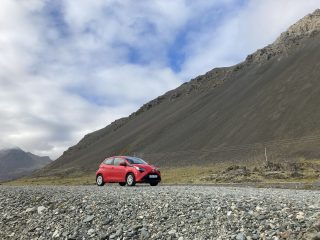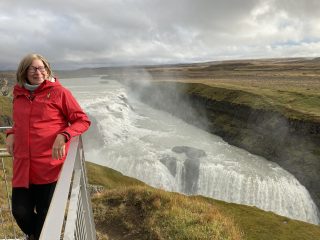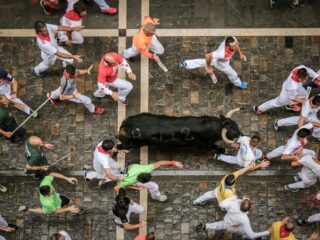by Laima Vince
Having reached an age where I am no longer needed by anyone, I am free to take to the open road. I am a driver with grit, and that means I’m not a timid driver, but not a recklessly fearless one either. I drive an ancient Toyota stick shift on gravel back roads, and I can cruise through New York City without breaking a sweat. All this, I felt, prepared me to drive Iceland’s 828-mile (1,332 km) two-lane Ring Road solo, encircling the island in seven days. What I was not prepared for was the stunning beauty of the land I would witness and how deeply Iceland would sear into my soul.

As I was about to board my flight to Reykjavik from Riga, Mads, a Danish friend, texted me a link to the Icelandic sagas, required reading for him in high school in Copenhagen. He wrote that I ought to read Gísli the Outlaw on the plane to prepare me for my own Icelandic saga.
This saga tells the story of Gísli, a tragic hero who must kill one of his brothers-in-law to avenge another brother-in-law. Gísli is forced to stay on the run in Iceland for thirteen years, relying on his dreams for guidance, making many mistakes along the way, before he is finally hunted down and killed. The saga takes place between 860 and 980. Unlike Gísli, I was not on the run in Iceland, but I had one simple wish: to see the Aurora Borealis. This desire set me on the road circling Iceland chasing the Northern Lights.
As the plane took off, I read: So, they put to sea, and have Iceland in their mind’s eye.
Over a thousand years ago, just like us travelers today, Gísli and his clan had Iceland in their mind’s eye as they set sail from Norway. The legendary Gísli began his journey in Iceland on the West coast where they first made landfall.
Heading West from the airport, I drove through a tunnel under the sea in Hvalfjördur and marveled at this engineering wonder. It would be the first of my many tunnels traversed in Iceland.
Iceland’s language is that of colors – the preternatural brilliant aquamarine of mineral fed waters, the sharp relief of an azure sky against a mountain ablaze in autumnal transformation, the shock of a simple white A-frame church set against deep blue waters and a sky bursting cerulean. These are just some of the gifts of the road.
Other three years Gísli spent in roaming over the land and going from house to house asking help and countenance from great chiefs; but something always tripped him up everywhere, so that naught came of it.
The road teaches me that nothing is meant to be easy.

The little red Toyota Aygo I rented handled more like a golf cart than a car, and the engine had about as much pickup as a lawnmower going up steep mountains. I made miscalculations and errors in judgment along the way. I should have had a topographical map. My experience judging distance in flat landscapes proved ineffective in mountainous Iceland. Only I could manage to approach a major tourist attraction like the Blue Lagoon from the wrong side, driving two hours through a volcanic landscape to the geo-thermal power plant in Grindavik. I over planned, went backwards 50 miles from Akureyi just to see Sigulfjörd, a town situated on one of Iceland’s farthest points north. And then I just had to hike to Dettifloss, Europe’s largest waterfall, at sunset, which meant that to reach my next stop I found myself driving mountain roads through the night, listening to shrill haunting experimental Icelandic compositions on the radio. I got caught at night in fog at the top of the fjord that leads down to Seydisfjörden. The strong calm voice of the Icelandic woman calling from Hotel Alden to see if I was still coming lured me onwards: “We are used to it. You are not. Just keep driving and do not stop.”
Yet, I am grateful for all my detours and blunders because each one revealed more hidden gems of Iceland’s majestic, lonely hinterlands. Ultimately, I survived all my mistakes, which may mean that on some level they were intentional after all.
Gísli the Outlaw survived his mistakes in Iceland as well, at least initially.
All wise men are of one mind that Gísli lived an outlaw longest of all men, save Grettir, the son of Osmund. Eighteen years was Grettir an outlaw.
Mads also suggested I acquaint myself with trolls. My first evening in Iceland, at the Fossatún campground, I strolled the Troll Garden Path. Sheep struck picturesque poses on rugged outcroppings of cliffs, as though accustomed to being photographed. The owner of the campground, Steinar Berg, had written a series of children’s books about trolls, which were translated from Icelandic into French, German, and English, and available for sale in the campground café. The troll heroes of these books come alive in the barren hilly landscape. If you happened to glance up while brushing your teeth, you may see the hunched figure and bulbous nose of a seated troll ruminating against the pink glow of dawn or the orange sunset or the eerie green of the northern lights. Another hooved creature leaned over a cauldron. Informational signs (Icelanders are great fans of the informational sign) strategically located on the footpath provide narratives about trolls in four languages:
Some trolls, known as night-trolls, turn to stone if they are caught by the rays of the morning sun. Trolls have an aversion for the Christian faith and hate the sound of church bells ringing. Sometimes trolls are cannibals and look for ways to catch and eat humans. The best known of these is a female troll called Gryla. She likes to eat small children and it is said that she can hear them from a great distance when they are naughty or crying.

After a soak in the campground hot tub, luxuriating while watching the sky aglow in the orange tones of a slow northern sunset, I slid into my sleeping bag, settled inside the camping pod—a cozy wooden concave structure reminiscent of a miniature airplane hangar—and continued reading: Gísli was a foresighted man and a great dreamer, and he dreamt true. References to Gísli’s dreams and their interpretations abound in the saga.
Then slumber steals over him, and he dreams that fowl came into the house called nighthawks: they are larger than ptarmigan, and they looked evil, and had been wallowing in gore and blood.
Like Gísli, I am a great sleeper and a dreamer: jet lag did me in and I fell into a deep sleep. I woke as the sun was struggling up the side of the mountain behind the campground. I had slept through the Northern Lights. In the camp toilet a German woman named Petra told me about the spectacular light show she’d witnessed in the sky last night.

Most people navigate the Ring Road from south to north, but I was traveling in September and knowing that the weather would only get colder and the nights shorter, I headed north and circled round to the south. As I drove through cool early morning mist, steam rose from geysers dotted across the barren landscape. I passed Icelandic wild horses grazing in the fields, dark clay-colored mountains that look like enormous mounds of mud, or sometimes sand.

The Ring Road took me between mountain passes, across valleys, high up into heights with steep drops on either side and no guard rails, just evenly spaced posts with reflectors to help navigate anyone foolish enough to drive these roads at night. I saw a mountain backlit almost black, sunlight illuminating a verdant pasture at the mountain’s very edge, a lone white church with a bright red roof popping against the green, dotted with white sheep, heads down, grazing. I saw rust-colored fields with a backdrop of mountains dotted with snowy caps. I saw a splash of aquamarine in the center of the red earth, a lake out in the middle of nowhere with no road to reach it. I saw rushing rivers burst forth from between vertical walls of stone. I saw a field, half of it golden, abutted against dark barren hills, and at the foot of the hills, a white farmhouse with a sky-blue roof. I turned a corner and the Atlantic emerged, its wavelets glowing silver and blue. The road has its monuments and is scattered with cairns. Icelandic ponies gaze at you with watery eyes, inviting you to stroke their thick manes.
But though Gísli had not been hunted down, he sees plain enough that he must be taken, and that very soon, if he stays there.
I have lain awake at night sometimes wondering what it will feel like to die. Will I close my eyes and the world would go dark, my consciousness dissipating like the geyser’s bubbling mud? Driving the Ring Road, as I emerged from the darkness of a deep tunnel cut through a mountain too high to see its peak through my windshield, an expanse of golden moss clinging painfully to gray volcanic boulders emerged, stretching outwards to the very edge of my vision. Then the sun streamed in from between clouds and suddenly the land was gilded. And I realized – this is what it will feel like to die.
My second night, I stayed on a horse farm in Glaesibar, just outside of the northern city of Akureyi. An older slim Icelandic man has run this horse farm since 1986. The Icelandic horse has been around for 1,000 years, he tells me. As we talked, clouds moved in across the clear skies. That night the northern lights proved elusive and out of my reach. Or perhaps they were dancing their magic behind the curtain of thick clouds.

I read more of the sagas that night as I drifted off to sleep – murders and betrayals abound. Following my host’s suggestion, the next morning I ventured off the Ring Road up the fjords to the fishing town Sigulfjördur. I was forewarned that I would encounter three tunnels that cut through the mountains and that two of them would be narrow single-lane tunnels that fit only one vehicle at a time – if you see a pair of headlights heading your way, you must swerve into a cutout carved into the mountain.
I encountered my first tunnel in Dalvik, a tiny fishing hamlet with a population of 1,400. I braced myself and entered the narrow single-lane tunnel, keeping a sharp eye out for oncoming vehicles. I passed through the tunnel without incident. Next came Olafsfjördur, a former herring fishing hub, now a quiet town with a population of roughly 750, connected by two tunnels to the rest of the region.
I emerged in the town center. The sky was clear with that light of the far north. I strolled the vacant streets, and for the first time in my life I heard the sound of silence. It was so silent that my ears rang from the lack of sound. A lone woman rode past on a bicycle and waved to me with great familiarity, flashing a smile. Otherwise, I met no one.

I negotiated the next tunnel – thankfully with two-lanes – and drove into one of Iceland’s northernmost towns, Silgulfjördur. Nestled between mountains and a cove that reflects the façades of brightly painted houses, this former herring fishing town now attracts tourists. I wandered the streets and photographed the blue, pink, purple, and green houses, the murals. As I traveled around Iceland, I saw playfully painted façades everywhere. In the dark gloom of a long winter, they provide a beacon of brightness with their whimsical colors and images.

In Sigulfjördur I came across a statue of a man reading a book, a monument to a local person of significance. This is how the community chose to remember him. Iceland has one of the highest literacy rates in the world and there is a distinct love for books that can be felt all over. In every hostel I stayed in, every farmhouse, every campground, there is a reading nook with bookshelves filled with old books in English and Icelandic. Nowhere did I see screens.
I drove to Seydisfjörden, nestled between fjords, survivor of mudslides. I walked the rainbow path to the town’s quaint wooden church. Here houses are built in the old Scandinavian style with boards running vertical rather than horizontal.

I drove hugging the coast to Djupivogur, where I slept in a wooden camping barrel.
That evening I dined on meat soup at the inn and chatted with the Polish waiter.
“I will never go back to Poland,” he said. “I earn enough here, even after cost-of-living expenses, to save fifty percent. I can travel and party with my Polish friends in the UK.”
Iceland’s service industry is run by polite East European youth while Icelanders own the businesses. You’ll be hard pressed to encounter a true Icelander behind any counter in Iceland.

Driving from the east along the southern coast towards Hofn, I passed amazing inlets, water worlds populated with regal swans. I sighted a brace of swans flying together across blue waters, necks outstretched.
Outside Hofn, I tried to walk a gravel road to an ice field glittering in the distance, but the distance proved too far, and I eventually had to turn back. That walk gifted me the opportunity to hear silence again. Later, down the road, I was able to walk close to a glacier and feel its icy breath on my face. There is a reason why you must walk up close to a glacier, feel its thousands of years old cold, the lick of its icy tongue, listen to its secrets. The ice of the glacier carries the wisdom of lost ages frozen within. The glacier holds the reflections of the stars from millenniums past, the murmurs of the first life on this planet. The glacier is our collective memory of ice. Its ice holds the beginnings of the world.

I followed the ice fields and glaciers along the edge of Vatnajökull National Park. I’d reached the outer limits of the earth, where the icy waves of the Atlantic seek to lick the glacier’s ice face. I stopped often simply to listen to the sound of ice and ocean, and silence. Suddenly, at Jökulsárlón Glacier Lagoon, icebergs burned white against aquamarine waters. There I encountered tour buses and crowds. It came as a complete surprise. Tourists walked around dressed as though they were setting out on an Arctic expedition.
I drove to Vik, passing through a lava landscape of tousled black earth encased in slow-growing moss. Having spent the night at the Vik Hostel, I followed the Golden Circle route, Gysir, Gullfoss, and Thinvellir National Park, a pleasant and easy Iceland. I stayed at the Estidalur farm, where the same family has farmed the land for three generations. I dined on locally grown farm food in a dining room with a glass wall facing the cow barn. As you ate, you could watch the cows munching hay in their stalls.
South Iceland felt somehow diminished after the rugged landscape of the north. I was grateful that I had begun my journey in the mystical, harsh, lonely, desolate North. I had come to the end of my journey, and so had Gísli.
Gísli there lost his life with so many great and sore wounds that it was a wonder to see. They say that he never turned his heel, and none of them saw that his strokes were lighter, the last than the first. There now ends Gísli’s life, and it has always been said he was the greatest champion—though he was not lucky in all things.
I left Iceland not having seen the northern lights, although I did chase them. Perhaps one of the gifts of the road is that although we may not find what we chase, we will find what the road chooses to reveal to us, what we truly need.

Laima Vince has published her works of fiction, literary nonfiction, and literary translation with Columbia University Press, Central European University Press, Arc Publications, the Institute of Lithuanian Literature and Folklore, Alma Littera, Baltos Lankos, the Lithuanian Writers Union Publishers, White Pines Press, and Paris Experimental. Her essays have been published in Catamaran, The Vilnius Review, Poetry Daily, The Journal of Baltic Studies, and elsewhere. She earned an MFA in Writing from Columbia University, an MFA in Nonfiction from the University of New Hampshire, and a PhD in Humanities from Vilnius University. Laima Vince (Sruoginis) is the recipient of two Fulbright grants in Creative Writing and a National Endowment for the Arts award in Literature. She teaches Creative Writing in the English Department at the University of Southern Maine. To learn more about Laima’s work please see her website: www.laimavince.com











